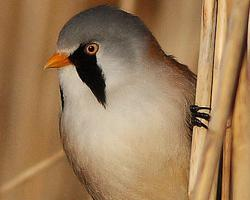
Starea de conservare
| Amenințat |
Descrierea animalului
The Bearded Reedling (Panurus biarmicus), also known as the Bearded Tit due to its superficial resemblance to the true tits despite not being closely related, is a small, enchanting bird that graces the reed beds of temperate Europe and Asia with its presence. This unique species, the sole member of the family Panuridae and genus Panurus, has captivated bird enthusiasts and nature lovers alike with its distinctive appearance, intriguing behaviors, and melodious calls.Adult Bearded Reedlings are easily recognizable by their striking plumage and the distinctive facial markings that give the species its common name. Males boast a remarkable appearance with a long, drooping mustache-like black malar stripe that extends from the base of the beak down the sides of the throat, which contrasts sharply against their light grey head and back. Their underparts are a soft orange hue, blending seamlessly into the reeds they inhabit. The tail is notably long and pointed, aiding in their acrobatic maneuvers through the dense reeds. Females and juveniles, while lacking the pronounced "beard," share a similar color palette but with more subdued tones, allowing them to blend effortlessly into their surroundings.
Measuring approximately 14-16.5 cm in length and weighing between 13-20 grams, Bearded Reedlings are small yet hardy birds. Their diet primarily consists of insects during the summer months, with a transition to seeds, particularly those of the reed, during the winter. This dietary flexibility allows them to thrive in their preferred habitats year-round.
The Bearded Reedling exhibits a strong preference for large reed beds adjacent to bodies of water such as lakes, marshes, and riverbanks. These dense reed environments provide not only the necessary food resources but also protection from predators and suitable nesting sites. The species is monogamous, with pairs forming strong bonds. Nests are artfully constructed from reeds and other plant materials, suspended above the water or ground within the reeds, where the female lays and incubates her eggs.
One of the most remarkable aspects of the Bearded Reedling is its resilience to cold temperatures. Unlike many small birds that migrate to warmer climates during the winter, Bearded Reedlings remain in their reed bed habitats, enduring the cold. This resilience is facilitated by their ability to store fat and change their metabolism to cope with the lower temperatures.
The Bearded Reedling communicates through a variety of sounds, from soft, warbling calls to sharp, metallic 'ping' calls that are often used to maintain contact between pairs or alert others to potential threats. These vocalizations add an auditory charm to the visually stunning reed bed habitats they occupy.
Despite facing threats from habitat destruction and degradation, particularly due to the drainage of wetlands and the removal of reed beds, the Bearded Reedling has maintained a stable population in many parts of its range, thanks in part to conservation efforts aimed at preserving and restoring vital wetland habitats. The species is currently listed as of Least Concern by the International Union for Conservation of Nature (IUCN), reflecting its relatively wide distribution and stable population numbers.
In summary, the Bearded Reedling is a small, resilient bird with a distinctive appearance and fascinating behaviors. Its preference for reed bed habitats and its melodious calls make it a joy for birdwatchers and nature enthusiasts. Through continued conservation efforts, this unique species will hopefully continue to thrive in its natural habitats, delighting future generations with its presence.
Fotografii noi cu animale
Top 10 animale
- Dolphin gull (Leucophaeus scoresbii)
- Diana monkey (Cercopithecus diana)
- Galápagos tortoise (Geochelone nigra complex)
- Moustached guenon (Cercopithecus cephus)
- Japanese macaque (Macaca fuscata)
- Stone loach (Barbatula barbatula)
- Giant peacock moth (Saturnia pyri)
- Russian tortoise (Testudo horsfieldii)
- Japanese spider crab (Macrocheira kaempferi)
- Colossal squid (Mesonychoteuthis hamiltoni)